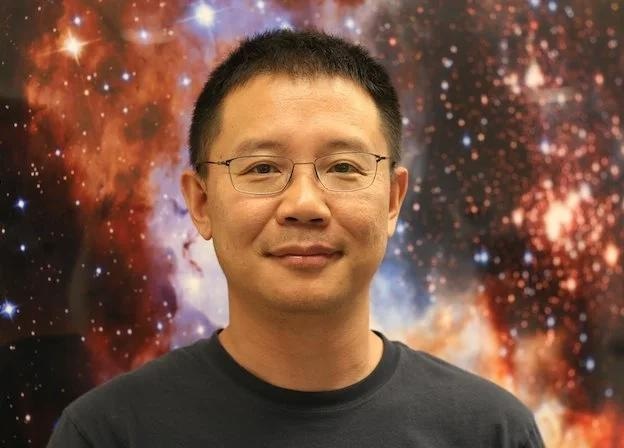Constituting an estimated 85% of the universe’s matter, dark matter is nonluminous and remains poorly understood.
 Hai-Bo Yu is a theoretical physicist with expertise in the particle properties of dark matter. Image Credit: Samantha Tieu
Hai-Bo Yu is a theoretical physicist with expertise in the particle properties of dark matter. Image Credit: Samantha Tieu
Unlike regular matter, which interacts with light through absorption, reflection, and emission, dark matter cannot be directly observed, posing challenges in its detection.
The theory known as “self-interacting dark matter” (SIDM) suggests that dark matter particles engage in self-interactions through an invisible force, leading to significant collisions near the center of galaxies.
In a study published in The Astrophysical Journal Letters, a research team headed by Hai-Bo Yu, a Professor of physics and astronomy at the University of California, Riverside, reveals that SIDM offers a plausible explanation for two astrophysical puzzles at opposite extremes simultaneously.
The first is a high-density dark matter halo in a massive elliptical galaxy. The halo was detected through observations of strong gravitational lensing, and its density is so high that it is extremely unlikely in the prevailing cold dark matter theory. The second is that dark matter halos of ultra-diffuse galaxies have extremely low densities and they are difficult to explain by the cold dark matter theory.
Hai-Bo Yu, Professor, Physics and Astronomy, University of California, Riverside
A dark matter halo refers to the unseen mass enveloping and encircling a galaxy or a cluster of galaxies. Gravitational lensing occurs when light from distant galaxies traversing the universe is bent around massive objects.
In the cold dark matter (CDM) paradigm, it is assumed that dark matter particles are collisionless. Ultra-diffuse galaxies, characterized by extremely low luminosity and a dispersed distribution of stars and gas, align with this paradigm.
Hai-Bo Yu, alongside Ethan Nadler, a joint postdoctoral fellow at the Carnegie Observatories and the University of Southern California, and Daneng Yang, a postdoctoral scholar at UCR, collaborated on the study.
To demonstrate that self-interacting dark matter (SIDM) can account for two astrophysical puzzles, the team conducted pioneering high-resolution simulations of cosmic structure formation, incorporating strong dark matter self-interactions on mass scales pertinent to the gravitational lensing halo and ultra-diffuse galaxies.
Nadler stated, “These self-interactions lead to heat transfer in the halo, which diversifies the halo density in the central regions of galaxies. In other words, some halos have higher central densities, and others have lower central densities, compared to their CDM counterparts, with details depending on the cosmic evolution history and environment of individual halos.”
The research team asserts that the two puzzles significantly challenge the conventional CDM paradigm.
CDM is challenged to explain these puzzles. SIDM is arguably the compelling candidate to reconcile the two opposite extremes. No other explanations are available in the literature. Now there is an intriguing possibility that dark matter may be more complex and vibrant than we expected.
Daneng Yang, Postdoctoral Scholar, University of California-Riverside
Additionally, the study illustrates the efficacy of investigating dark matter through astrophysical observations, utilizing computer simulations of cosmic structure formation as a valuable tool.
We hope our work encourages more studies in this promising research area. It will be a particularly timely development given the expected influx of data in the near future from astronomical observatories, including the James Webb Space Telescope and upcoming Rubin Observatory.
Hai-Bo Yu, Professor, Physics and Astronomy, University of California, Riverside
Since 2009, Yu and collaborators' efforts have played a key role in promoting the concept of SIDM within the particle physics and astrophysics communities.
The John Templeton Foundation and the US Department of Energy financially supported the study.
Journal Reference:
Nadler, E. O., et al. (2023) A Self-interacting Dark Matter Solution to the Extreme Diversity of Low-mass Halo Properties. The Astrophysical Journal Letters. doi.org/10.3847/2041-8213/ad0e09